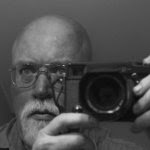My initial impressions of the newly-released Zeiss Ikon 50/1.5 Sonnar were based on images taken under dim light on fast film. While it was possible to glean some information on the signature of the lens when used wide open, it showed little about the lens’ sharpness at smaller apertures. In this test, I tried to kill two birds with one stone. Scientifically-speaking, that’s never a good idea. It wasn’t here either. To test the resolving capabilities of the Sonnar, I used Rollei 25 film (good idea). Then I developed it in Rodinal to see how it fares with Rollei 25 (bad idea). Rodinal was formulated in the 1800’s and has been in production continuously until about a year ago. It was developed when photographers used negatives that were the size of prints. While it is a great developer for 8”x10” negatives, it unabashedly doesn't reduce grain. So, when the negative is 24mm x 36mm, expect grain, even from Rollei 25.
Today was very bright and very humid. Instead of hassling with highlights and shadows of buildings, I drove out to a swamp. It was bright enough to shoot at f/5.6 at 1/60, so that’s what I did. This image is of some run down fishing camps off Airline Highway. The full frame doesn’t reveal much as I am too far from the camps. But enlarging a small area of the negative gives a good impression of what to expect from this lens (and film + developer).

For me, this lens is plenty sharp enough for my use. I tend to use 200 to 400 ISO films, and I think the weak link in the chain will be the resolving capabilities of the film, not this lens. I find Rollei 25 to be insufferably slow, to the point that I would not consider it for anything except landscape photography (with a tripod). I do think that the Voigtländer Heliar 50/3.5 is a much sharper lens, but it, too, is slow.

As much as I like high definition, I don't expect it when shooting 35mm. If I want large prints, I'll use a camera with large negatives.




<< Home